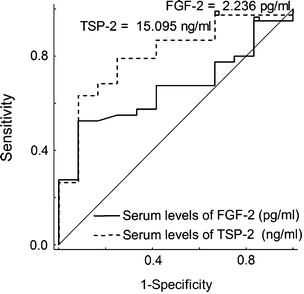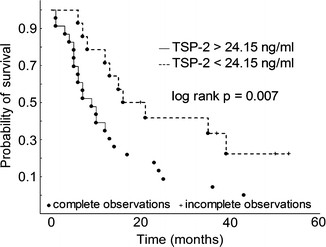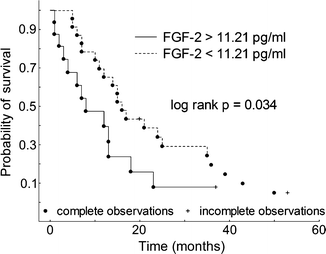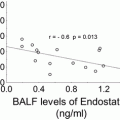Fig. 1
Serum concentrations of thrombospondin-2 (TSP-2) (a) and of fibroblast growth factor-2 (FGF-2) (b) in non-small cell lung cancer (NSCLC) patients and healthy control subjects
We constructed ROC curves of serum TSP-2 and FGF-2 to determine the cut-off values (Fig. 2). Specificity and sensitivity of serum TSP-2 in NSCLC patients relative to healthy people were 67 and 96 %, respectively, at a cut-off value of 15.01 ng/ml. Specificity and sensitivity of serum FGF-2 in NSCLC group relative to healthy subjects were 86 and 95 %, respectively, at a cut-off value of 2.24 pg/ml. The area under the curve for serum TSP-2 and FGF-2 were 0.81 and 0.66, respectively.


Fig. 2
Receiver operating characteristic (ROC) curves for serum thrombospondin-2 (TSP-2) and fibroblast growth factor-2 (FGF-2) in differentiating non-small cell lung cancer (NSCLC) patients from healthy people
There were no correlation between the levels of TSP-2 or FGF-2 and the stage of tumor (TSP-2 IIIB vs. TSP-2 IV: 25.51 ± 8.10 vs. 27.81 ± 8.20 ng/ml, respectively, p = 0.32; FGF-2 IIIB vs. FGF-2 IV: 9.20 ± 6.00 vs. 13.71 ± 9.30 pg/ml, respectively, p = 0.067).
We did not find a significant relationship between pretreatment concentrations of TSP-2 or FGF-2, and the effect of chemotherapy. After treatment we found a partial response (PR) in 18 (45 %), stabilisation (SD) in 10 (25 %) and progressive disease (PD) in 12 (30 %) patients (TSP-2: PR vs. SD vs. PD – 25.10 ± 8.50 vs. 25.24 ± 10.40 vs. 29.49 ± 6.60 ng/ml, respectively, p = 0.23; FGF-2: PR vs. SD vs. PD – 12.19 ± 11.00 vs. 12.76 ± 6.90 vs. 10.04 ± 7.20 pg/ml, respectively, p = 0.13).
The mean overall survival of all patients was 15.7 ± 13.0 months. The patients with elevated serum TSP-2 levels (TSP2 level >24.15 ng/ml) had a significantly shorter overall survival than those with lower serum TSP-2 levels (TSP2 level <24.15 ng/ml: 9.0 months vs. 23.7 months) (Fig. 3). The patients with FGF-2 levels >11.21 pg/ml had a significantly shorter survival than patients with FGF-2 <11.21 pg/ml (7.5 months vs. 16.0 months, respectively) (Fig. 4).



Fig. 3
Kaplan-Meier survival curve. The solid line represents survival of patients with thrombospondin-2 (TSP2) >24.15 ng/ml and the broken line of those with TSP2 <24.15 ng/ml. Patients with the TSP2 level >24.15 ng/ml had significantly shorter survival

Fig. 4
Kaplan-Meier survival curve. The solid line represents survival of patients with fibroblast growth factor-2 (FGF-2) >11.21 pg/ml and the broken line of those patients with FGF-2 <11.21 pg/ml. Patients with FGF-2 level >11.21 pg/ml had significantly shorter survival
4 Discussion
TSP-2 has recently attracted attention as an endogenous negative regulator of angiogenesis in tumorigenesis (Lawler 2000). However, functions and properties of TSP-2 are not well understood. Fontanini et al. (1999) reported no statistical differences between TSP-2 mRNA expression and microvessel density in NSCLC by RT-PCR. The opposite results were presented by Tokunaga et al. (1999). They reported that TSP-2 gene expression is correlated with decreased vascularity in NSCLC. Moreover, Chijiwa et al. (2009) reported that patients with pulmonary adenocarcinoma and a pattern of cancerous TSP-2 expression have a good prognosis. On the other hand, pulmonary adenocarcinoma patients with non-cancerous TSP-2 expressions pattern showed poor prognosis (Chijiwa et al. 2009). In a study of Chijiwa et al. (2009), cases with high TSP-2 expression level and good prognosis showed its strong cancerous expression, but not in lymphocytes. On the contrary, cases with high TSP-2 expression, but poor prognosis, showed its low expression in tumor cells, but high levels in lymphocytes (Chijiwa et al. 2009). In the present study, we showed a higher serum level of TSP-2 in NSCLC patients compared with healthy subjects. Moreover, patients with higher levels of TSP-2 had shorter survival. A possible explanation for TSP-2 increased levels in NSCLC group is its releasing from blood cells, endothelial cells, or other cells involved in the pathological tissue remodeling of cancer stroma (Zhang and Lawler 2007). Our results are in accord with those of Chijiwa et al. (2009). They revealed that the stromal TSP-2 expression is not enough to suppress growth of NSCLC, while the cancerous TSP-2 expression directly inhibits growth of the tumor (Chijiwa et al. 2009).
TSP-2 acts at the interface between the cell surface and extracellular matrix to provide contextual cues that regulate matrix structure and cellular phenotype during tumor growth (Lawler and Detmar 2004). One of the main regulators of matrix metalloproteinases production and invasiveness in human cancer cell lines is FGF (Corn et al. 2013).
FGF-2 belongs to a family of ubiquitously expressed ligands that bind to the extracellular domain of FGFRs (FGF Receptors), initiating a signal transduction cascade that promotes cell proliferation, motility, and angiogenesis (Ribatti et al. 2007; Mohammadi et al. 2005). Elevated levels of FGF-2 have been detected in NSCLC cell lines, but the precise role of these molecules in the pathogenesis and progression of this tumor is still unknown (Kuhn et al. 2004).
The first study investigating serum levels of FGF-2 in NSCLC was reported by Brattström et al. (1998). They demonstrated elevated serum of FGF-2 in NSCLC patients (Brattström et al. 1998). We confirmed that findings because NSCLC patients had higher levels of FGF-2 in serum than healthy people. In the present study, patients with higher FGF-2 serum levels had shorter survival than those with lower concentration of FGF-2 (7.5 months vs. 16 months). These observations are different from the study of Brattström et al. (1998) who found that elevated FGF-2 at diagnosis was a significant favorable prognostic factor for survival. However, these results disagree with other studies. In a study by Ueno et al. (2001) in 60 NSCLC patients, serum FGF-2 levels did not differ between the clinical stages of NSCLC and showed no correlation with survival. Neither did we find any correlation between the levels of TSP-2, FGF-2 and the stage of tumor. However, our observations on survival are compatible with some other works (Brattström et al. 2002, 2004; Joensuu et al. 2002). In the present study the elevated FGF-2 levels correlated with poor survival in NSCLC.
Stay updated, free articles. Join our Telegram channel

Full access? Get Clinical Tree




